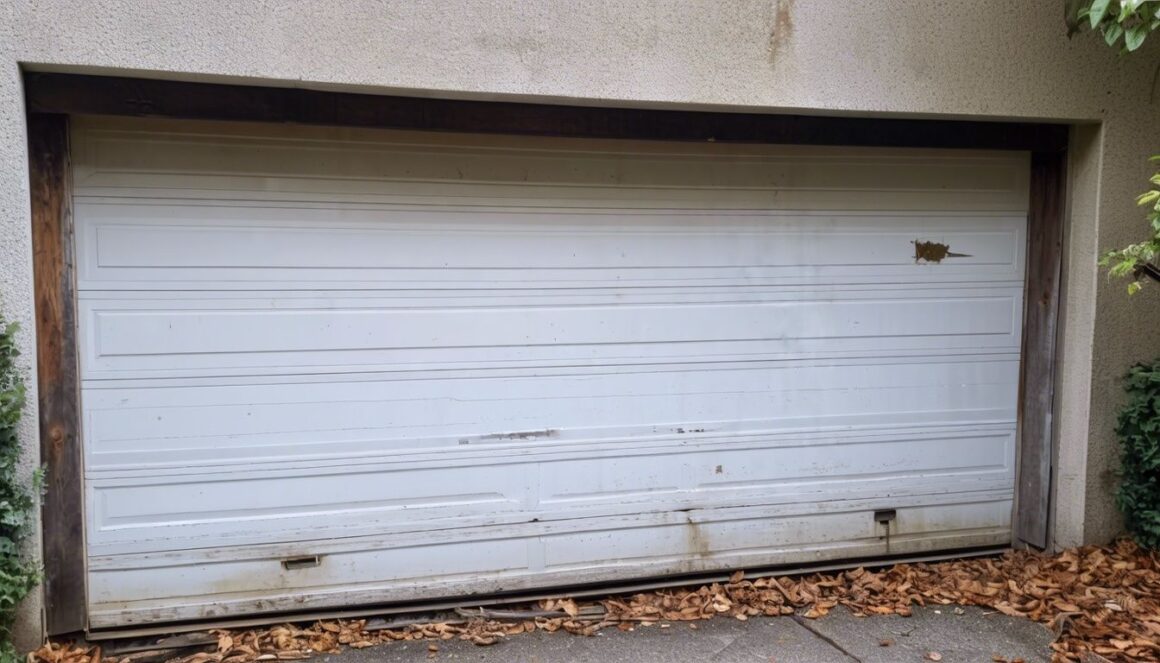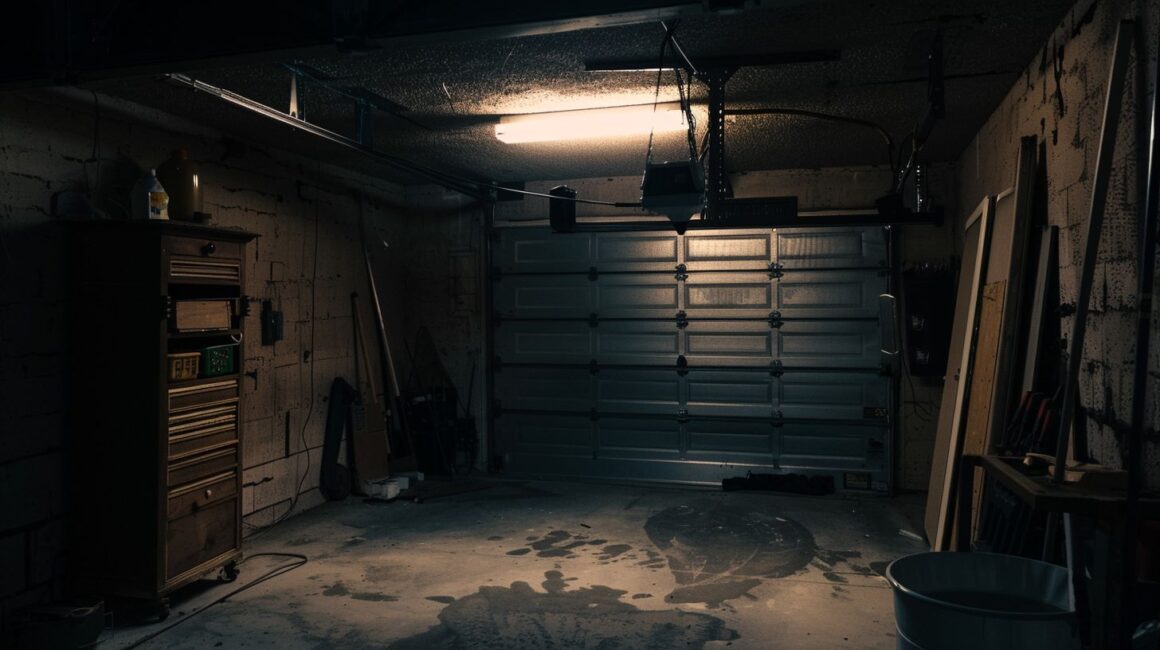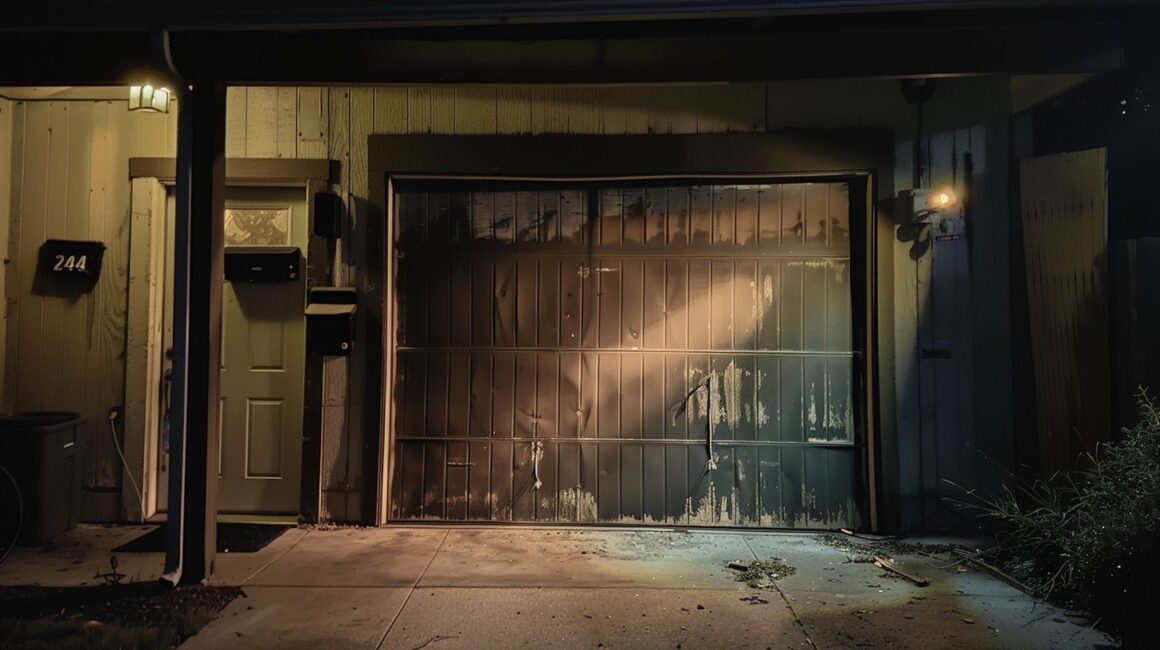Garage door wont go down? This common issue locks out safety and convenience from your home. Our article will guide you through seven straightforward steps to solve this problem, ensuring your door slides down smoothly once again.
Keep reading, help is on the way.
Key Takeaways
- Clean and align the safety sensors if your garage door won’t close. Dirty or misaligned sensors often mistake nothing for an obstacle, stopping the door.
- Check for broken springs, frayed cables, or anything blocking the door’s path. Don’t fix these yourself because it’s unsafe. Call professionals.
- If your door still doesn’t move, try adjusting the opener’s limit screws or replace its batteries. Simple fixes like these can make a big difference.
- Manually close your garage door to see where the problem is. This helps figure out if it’s with the door or the opener mechanism.
- When things get tough, like with bent tracks or serious technical issues, call in expert help to avoid injury and further damage to your garage system.
Possible Reasons for a Garage Door Not Closing
Garage door wont go down? It can be frustrating. Issues might be with the sensors, broken springs, or even something blocking its path.
Sensor issues
Safety lasers near the bottom of the door sometimes get dirty. This dirt can make them send signals that there’s something in the way when there’s nothing. It’s like they think a ghost is blocking the door! To fix this, you need to clean them up.
Also, these electric eyes might not look at each other straight. They’re supposed to be facing each other perfectly. If they don’t, it’s like they’re mad and not talking. You just have to realign them so they’re friends again and see eye to eye.
For cleaning, take a soft cloth and wipe the lenses gently. No special cleaner needed – just care and attention. When aligning, loosen their screws slightly, adjust so both sensors are parallel, then tighten back up.
I’ve done this myself more times than I can count! My garage now knows if it’s really blocked or if its sensors are just being fussy.
Broken springs or cables
Springs and cables do the heavy lifting to move your garage door. If they break, the door won’t go up or down. Check if the springs are intact and cables run smoothly without frays.
Each side must have equal tension, and the door should land evenly when it closes.
If you spot a broken spring or frayed cable, don’t try to fix them yourself. This job requires skills and tools only professionals have. They will safely replace these parts, ensuring your door works right again.
Always call a repair service for these issues to avoid danger.
Malfunctioning garage door opener
A broken garage door opener stops your door from moving. Check if the problem is the opener by detaching the garage door from it. If the door moves freely by hand, then yes, the opener or its controls have issues.
Replace batteries and use the “learn” button to reprogram. This simple step often fixes many opener problems.
If troubles continue, inspect cables and springs for damage. Sometimes these parts break and affect how openers work. Regularly lubricate moving parts to prevent future malfunctions.
Keep an eye out for warning signs such as strange noises or slower movements that could indicate a failing garage door opener needing attention or replacement.
Obstructions on the tracks
Stuff on the tracks can stop your garage door from closing. Toys, tools, or even small rocks can block the path. Make sure to remove these items so the door can move smoothly. Also, check for bent tracks or damaged rollers.
If you find any bends or damage, this might be why your door won’t close all the way. Bent tracks need a quick fix or replacement to get your garage door back on track and closing properly again.
Power outage or manual lock engaged
Sometimes, no power means your garage door won’t move. Check if other devices work to see if it’s a blackout. If yes, wait until the power comes back. Garage doors have manual locks for safety.
Find them near the bottom or side. Unlock these to try opening the door by hand. This might get your garage working until you can fix it right.
Pulling the rope towards the door resets the trolley latch after disengaging the disconnect switch during a power cut or when manually locked. This simple step often gets things moving again without needing tools or calling in professionals from a “garage door company.”.
Troubleshooting Tips for Fixing a Garage Door That Won’t Close
Having trouble with a garage that won’t shut? Don’t worry, fixing it might be simpler than you think. Start by checking the sensors and ensuring nothing is in the way of the tracks. Also, consider whether your garage’s functionality could be impacted by its dimensions, such as the typical garage depth, ensuring the space accommodates your vehicle and allows the door to operate smoothly.
If that doesn’t do the trick, try tweaking the limit adjustments on your opener. Sometimes, changing the power source units for your handheld operator can help too. And if all else fails, you might need to switch off the manual disconnect feature or close it by hand to get things moving again.
These steps are straightforward and can save you time and stress before calling in an expert.
Checking the sensors and tracks
Garage doors often refuse to close due to sensor and track issues. Aligning sensors and cleaning tracks can solve this problem quickly. Here’s how:
- Look for blinking lights on the sensors; this signals misalignment. Move the sensors slowly until their lights stay steady, showing they’re in line.
- Clean any dirt or debris off the sensor lenses with a soft cloth. A dirty lens can block the infrared beam, preventing the door from closing.
- Inspect the tracks for obstacles like stones, sticks, or garbage that might stop the door from moving. Remove these obstructions carefully.
- Check for bends or damage in the tracks. Even small dents can cause big problems for garage doors.
- Make sure nothing hangs near or touches the garage door sensors because even spider webs can trigger false safety alerts.
- Test if the garage door closes smoothly by hand to confirm no physical blocks exist on the tracks that might not be immediately visible.
7.seriously consider calling a professional if unfixable track damage is found or if realigning sensors doesn’t fix the issue.
By following these steps, most sensor and track problems causing a garage door not to close can be identified and corrected with ease.
Adjusting limit screws
Adjusting limit screws makes your garage door close right. It’s a key step in troubleshooting. Here’s how you do it:
- Find the limit screws on your garage door opener. These are usually on the side of the motor unit.
- Use a screwdriver or a wrench to turn the screws. The exact tool depends on your opener model.
- Turn the limit screw marked “Close” clockwise if your door doesn’t shut all the way. This tells the door to lower further before stopping.
- If your door closes and then opens back up, turn the “Close” screw counterclockwise. This reduces how far down the door goes before stopping.
- Project beams from sensors near tracks must align for safety; misalignment can prevent closing even with correct limit adjustments.
- Check every quarter-turn to see if the adjustment helps your door close properly.
- If fine-tuning these screws gets tough, asking for expert help is wise to avoid damage or frustration.
Following these steps directly targets and solves one common problem without unnecessary confusion or delays.
Replacing transmitter batteries
Dead transmitter batteries often stop a garage door from closing. You can fix this quickly by using the “learn” button to replace batteries and reprogram.
- Find the transmitter on your garage door opener.
- Locate the battery cover. Slide or unscrew it according to your model’s design.
- Take out the old batteries. Note their size and type, usually AA or AAA, maybe even 9V.
- Get new batteries of the same size and type. Insert them correctly, matching + and – signs.
- Replace the battery cover securely.
- Press the “learn” button on your garage door opener’s motor unit—it might need a ladder to reach.
- Hold down the button until you see a light flash or hear two clicks, signaling it’s ready to pair with the transmitter.
- Test the transmitter by pressing its button to close or open the garage door.
- If the door responds, congrats! You’ve replaced your batteries successfully.
- No response? Check if you inserted batteries correctly or try reprogramming again, following steps 6-8.
This process ensures your garage door will go up and down without trouble, all with a simple battery swap and reprogramming step using the “learn” button on your opener’s motor unit.
Disengaging the disconnect switch
A stuck garage door can cause frustration. The disconnect switch is often the culprit. Here’s how to fix it:
- Find the rope with a handle hanging from your garage door mechanism. This rope is the manual release that disengages the trolley.
- Pull the rope toward the door to reset the trolley latch. Make sure you do it with a firm, steady motion.
- Check if the opener is plugged in properly. Sometimes, it’s as simple as a disconnected power source.
- Look at your opener’s control panel for a “lock” button feature. Press it to ensure it’s not activated, which prevents remote operation but allows manual use.
- Inspect for any signs of wear or damage on the rope or handle itself. Replace them if necessary.
- After disengaging, try opening or closing your door manually to test smoothness of movement.
- Reconnect your opener by attaching the trolley to the carriage once again.
8.lubricate all moving parts after reconnecting to ensure smooth operation in future uses.
Ensuring these steps are followed can quickly resolve issues related to a disconnect switch and get your garage door moving again without needing professional help immediately.
Manually closing the door
Manually closing your garage door is a straightforward process that can help you pinpoint the problem. It shows if the issue lies with the door itself or the opener mechanism.
- Pull the bypass rope. This disengages the door from the opener, letting you move it by hand.
- Inspect for any objects in the way of the door’s path. Remove these to ensure nothing blocks its movement.
- Slide the door down carefully. If it moves smoothly, the problem might be with the opener, not the door.
- Close the door completely to see if it aligns properly at the bottom. Misalignment suggests issues with tracks or rollers.
- Securely fasten a bolt in the tracks if needed to keep it shut temporarily.
- Check for ease of movement. The door should glide freely without much effort or noise.
- Note how heavy the door feels while closing it manually—this can indicate whether springs are functioning correctly.
- Once closed, verify that both sides of the garage door touch the floor evenly to confirm there’s no tilt.
Performing these steps can give you key insights into what may be causing your garage door to not close properly and whether you can fix it yourself or need professional help.
When to Call a Professional Garage Door Repair Service
Sometimes, fixing a garage door needs expert hands. If your door’s tracks are bent or you can’t solve the problem yourself, it’s time to call in a professional repair person.
Damaged or misaligned tracks
Garage doors can stop closing if their tracks are damaged or don’t line up right. Doors weigh a lot and over time, this weight can bend or twist the tracks. Sometimes, bolts holding the tracks get loose too.
This makes the door stick or not close at all.
Fixing these problems is hard work. Bent or warped tracks might need new ones to replace them. It’s smart to call professionals for help here. They have tools and know-how to fix track issues safely and quickly without making things worse.
Serious issues beyond basic troubleshooting
For problems beyond basic fixes, it’s time to call experts. Damaged or misaligned tracks in your garage door system demand professional repair skills. These aren’t easy DIY fixes and trying them on your own can make things worse.
Broken springs and cables are dangerous too. A spring under tension has enough force to injure someone seriously. Only technicians with the right tools should handle these tasks.
Also, if you face issues with the garage door opener’s inner workings—like motor failure or electrical faults—it’s a sign to get help. Modern openers use complex tech that needs an expert eye for both safety and functionality reasons.
Trying to fix these sophisticated gadgets yourself could void warranties or lead to costly mistakes. So, save time by calling professionals who have experience with Chamberlain models among others, ensuring your garage door works perfectly again without risking injury or further damage.
Safety concerns
Fixing a garage door on your own can be risky. Preload tension in broken doors is dangerous. Always check that counterweight ropes are tight and the door lands smoothly to avoid accidents.
Torsion springs hold much tension and can cause serious injury if they snap. If you see uneven gaps or hear loud noises when the door moves, stop immediately. These signs mean something is wrong inside where it’s risky to fix without training.
Professionals know how to safely handle these parts. They wear protective gear and follow strict safety rules to avoid accidents. For issues like misaligned tracks or broken cables, calling a professional ensures your safety.
Trying to fix these can lead to more damage or hurt someone badly.
Conclusion
Fixing a garage door that won’t lower can seem tough. Yet, seven clear steps guide the way to do it yourself. Check sensors and tracks, adjust screws, change batteries, flip switches, or manually close as needed.
For bigger issues like damaged tracks or safety worries, get professional help fast. Good maintenance keeps your door working well for years.
FAQs
1. Why won’t my garage door go down?
Your garage door might not close due to misaligned sensors, blockages in the door’s path, or issues with the opener. Check for obstructions and ensure the safety sensors align properly.
2. How do I fix a misaligned sensor?
First, locate the safety sensors at the bottom of your garage door frame. Loosen their mounting brackets slightly and adjust them until they face each other directly. Tighten the brackets and check if this solves the problem.
3. What should I do if there’s an obstruction?
Inspect the track for any objects that could block the door’s path. Remove anything you find and try to operate your garage door again.
4. Can holding down the button help?
Yes, holding down the button on your wall control may override sensor issues or minor obstructions allowing your garage door to close temporarily.
5: When should I call a professional?
If basic troubleshooting doesn’t fix your issue—like when sensors are clean and aligned but lights still blink—it’s time to call a technician for expert repair service.
6: Do opener malfunctions cause doors not to close?
Absolutely! If none of these steps work, it could signal an internal problem with your opener or even something more complex like a broken spring or cable malfunction requiring professional attention.

Alina Lee, a 35-year-old writer and horticulture enthusiast, brings nine years of expertise to the world of gardening writing. Her journey began with a solid foundation in agriculture, having graduated from Kansas State University in Manhattan, Kansas, with a degree in Agronomy. Alina’s academic background provides her with a unique perspective and a deep understanding of the intricacies involved in cultivating and nurturing plants.
With a passion for greenery and a commitment to sharing her knowledge, Alina has emerged as a prominent figure in the gardening community. Her articles not only reflect a wealth of experience but also a genuine love for the subject matter. Currently serving as a Senior Editor at Home and Around Blog, Alina plays a pivotal role in shaping content related to gardening and outdoor living.
Alina’s writing transcends mere information; it is a blend of practical advice, scientific insights, and a touch of inspiration for both novice and seasoned gardeners. Her commitment to fostering a deeper connection between individuals and nature is evident in her work. As a Senior Editor, Alina Lee continues to influence and inspire readers, contributing to the ever-evolving landscape of gardening literature with her extensive knowledge and passion for plant life.



